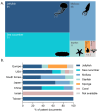How Significant Are Marine Invertebrate Collagens? Exploring Trends in Research and Innovation
- PMID: 39852504
- PMCID: PMC11766948
- DOI: 10.3390/md23010002
How Significant Are Marine Invertebrate Collagens? Exploring Trends in Research and Innovation
Abstract
This review is focused on the research, innovation and technological breakthroughs on marine invertebrate collagens and their applications. The findings reveal that research dates back to the 1970s, and after a period of reduced activity, interest in collagens from several marine invertebrate groups was renewed around 2008, likely driven by the increased commercial interest in these biomolecules of marine origin. Research and development are predominantly reported from China and Japan, highlighting significant research interest in cnidarians (jellyfish), echinoderms (sea cucumbers, sea urchins and starfish), molluscs (squid and cuttlefish) and sponges. Co-word analysis of the literature highlights applications in regenerative medicine, the properties of hydrolysates, and biology and biochemistry studies. Innovation and the technological landscape, however, focus on fewer taxonomic groups, possibly reflecting the challenge of sustainably sourcing raw materials, with a higher number of patents coming from Asia. Globally, jellyfish collagen is the most prominent marine invertebrate source, while Asia also emphasizes the use of collagens derived from molluscs and sea cucumbers. Europe, despite fewer patents, explores a broader range of taxonomic groups. Globally, key applications registered are mostly in medical, dental and toiletry areas, with peptide preparations spanning multiple animal groups. The food domain is notably relevant for molluscs and sea cucumbers. Market trends show a strong presence of cosmetic and supplement products, aligning with market reports that predict a growing demand for marine collagens in cosmetics and personalized nutrition, particularly in targeted health supplements.
Keywords: application; biomaterials; blue biotechnology; jellyfish; molluscs; patents; sea cucumber; sponges.
Conflict of interest statement
The authors declare no conflicts of interest.
Figures









Similar articles
-
Current Progress in Lipidomics of Marine Invertebrates.Mar Drugs. 2021 Nov 25;19(12):660. doi: 10.3390/md19120660. Mar Drugs. 2021. PMID: 34940659 Free PMC article. Review.
-
Extraction and characterization of collagen and gelatin from body wall of sea cucumbers Stichopus horrens and Holothuria arenicola.PeerJ. 2024 Oct 10;12:e18149. doi: 10.7717/peerj.18149. eCollection 2024. PeerJ. 2024. PMID: 39399433 Free PMC article.
-
Biomaterials and Bioactive Natural Products from Marine Invertebrates: From Basic Research to Innovative Applications.Mar Drugs. 2022 Mar 22;20(4):219. doi: 10.3390/md20040219. Mar Drugs. 2022. PMID: 35447892 Free PMC article. Review.
-
Echinoderms: their culture and bioactive compounds.Prog Mol Subcell Biol. 2005;39:139-65. Prog Mol Subcell Biol. 2005. PMID: 17152697 Review.
-
Collagen of Extracellular Matrix from Marine Invertebrates and Its Medical Applications.Mar Drugs. 2019 Feb 14;17(2):118. doi: 10.3390/md17020118. Mar Drugs. 2019. PMID: 30769916 Free PMC article. Review.
Cited by
-
Jellyfish Collagen in the Mediterranean Spotlight: Transforming Challenges into Opportunities.Mar Drugs. 2025 May 3;23(5):200. doi: 10.3390/md23050200. Mar Drugs. 2025. PMID: 40422790 Free PMC article. Review.
References
Publication types
MeSH terms
Substances
Grants and funding
LinkOut - more resources
Full Text Sources

